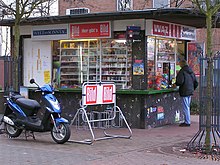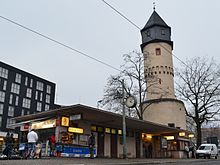Trinkhalle (sales point)

A pump room is a sales stand for water, alcoholic and non-alcoholic beverages and things of immediate use such as tobacco , confectionery (and similar luxury goods ), food and media. Many drinking halls also serve as acceptance points for the lottery and toto and sell newspapers or magazines and, to a limited extent, tickets for local public transport .
They are not to be confused with the so-called fountain hall, which is also often referred to as a “drinking hall” , in which, as part of a health resort in health resorts, fresh healing water is served to the health resort guests.
The first drinking halls, which initially only served the sale of non-alcoholic beverages, emerged in the second half of the 19th century in the course of industrialization and spread across large parts of Germany . Other common names today are Kiosk (in northern and southern Germany, Switzerland ), Bude (in the Ruhr area ) and Büdchen (in Düsseldorf , Cologne and Wuppertal ), Wasserhäuschen (in Frankfurt am Main and the surrounding area), Spätverkauf or Spätkauf or Späti ( in Berlin , Dresden and Leipzig ), Nebgenbude (Hanover) and partly also Budike (for kiosks that serve as drinking halls in Berlin).
In Austria , drinking halls with sales offers based on the German model are completely unknown.
history
Tap water used to be a health risk when it was not boiled. Instead, the workers drank beer and schnapps , the consumption of which was initially supported by the mine and factory owners through so-called “schnapps donations”. In order to curb the rampant alcoholism , the cities promoted the establishment of drinking halls where mineral water and other non-alcoholic drinks were offered. They were mainly created in front of the gates of collieries or factories , later also in other public places. Most of them were run by former miners or miners who were no longer able to work or war veterans.


A special feature were the so-called "milk drinking halls" that offered milk and milk products .
Over time, the range changed and expanded more and more. In the meantime you can find almost everything in drinking halls that you might need after the shop closes or on the weekend: drinks (including alcoholic ones), tobacco products, newspapers and magazines, sweets - also in individual combinations as colorful bags - ice cream products and groceries for everyday use, meanwhile also phone cards and mobile phone top-ups. The transitions to the corner shop , to the newspaper and / or tobacco product sales stand , to the snack stand ( snack bar ) or even to the snack bar with mostly simple furniture are often fluid. The opening times have been aligned with the opening times of pubs and restaurants. Drinking halls are entitled to serve non-alcoholic drinks. In the course of the relaxation of opening / serving times, drinking halls can now be operated around the clock, just like their competition, the 24-hour petrol stations and the quick shops that are increasingly found in larger cities . Recently, numerous postal agencies have also been housed in drinking halls.
The "Düsseldorfer Büdchentag" has been taking place every year since 2016. The Büdchenkultur is celebrated with many actions and attention is drawn to the approximately 650 Büdchen in Düsseldorf. Because the Büdchen has a special role as a meeting point for the neighborhood.
Drinking halls are divided into accessible and non- accessible . With the former, the customer can enter a small shop . Non-accessible drinking halls sell the goods through a (sliding) window to the outside. Bound drinking halls belong to a corporate chain and are leased , whereby the lessee is obliged to buy from certain suppliers on their terms. Non-tied drinking halls can design their shopping freely.
In some cases, drinking halls are no longer to be found only as independent buildings, but also as additions to residential or commercial buildings or as part of traffic structures and pavilions near train stations and busy places as well as in shops in buildings, preferably in corner locations. In addition, “drinking halls” nowadays often appear under other common names that are mostly only regionally widespread, such as kiosk , Bude and Büdchen , Wasserhäuschen , Budike and Spätverkauf , Spätkauf and Späti .
Local variants
Water house

The first water houses were built in Frankfurt am Main in the second half of the 19th century, when it was possible for the first time to fill bottles with mineral water ( called Bitzelwasser in Frankfurt ) and to close it so that the gas pressure was maintained. The Jöst company was founded in 1899 and until 1971 owned most of the Frankfurt drinking halls and most of the others to the Krome brothers. Most of it was sold by Jöst to the Henninger brewery .
Initially, mineral water was served, whereby the Krome Brothers also sold so-called "click water" (fizzy lemonade in ball- cap bottles , where a ball is known as a clicker in Frankfurt vernacular), which helped to increase its popularity. This contributed to the popular parlance of water houses.
After the First World War , the water houses came into economic distress due to a lack of raw materials. This was countered by expanding the range to include tobacco, chocolate, fruit and newspapers. In addition, many war invalids and lower-class workers found work there, so the city authorities continued to tolerate the water houses.
In the time of National Socialism , a large number of the water houses were simply demolished, except for those of the Jöst company, which sympathized with the system.
After the Second World War , many stalls were rebuilt, some were built on rubble lots using the remains of destroyed houses that had not yet been rebuilt. At times there were up to 800 water houses in Frankfurt am Main, which u. a. It was thanks to the fact that their opening times were not tied to the long rigid closing times . In the evenings and on weekends, the citizens could not get their food anywhere else, especially since the petrol stations at that time still mainly lived from selling petrol and were not supermarkets.
In the post-war period , the water houses were therefore a necessary facility, even if it was not loved by the authorities. Noise and odor nuisance, the lack of toilets and, last but not least, drunken water house regulars (known as Volleul ' or Hefköpp in Frankfurt ) led residents and investors to take action against water houses and the authorities were reluctant to grant or extend concessions. In addition, many of the houses built in place of war-torn buildings had to give way to more profitable new buildings or new urban planning concepts. In addition, the shops at the petrol stations partly took on the function of water houses.
It was not until the mid-1980s that nostalgia for a water house ensured that the “water house death” subsided. Today , the owners of the approximately 280 remaining Frankfurt water houses are mostly large breweries and beverage publishers who lease the stand to the operator. The water house is therefore an integral part of everyday life in Frankfurt to this day. Confessing water house fans are z. B. the writers Martin Mosebach and Eckhard Henscheid .
On August 19, 2017, the 1st Frankfurt Water House Day took place in Frankfurt am Main under the motto "A Frankfurt Original Celebrates", on which eleven different water houses and drinking halls hosted many different events. The Frankfurter Wasserhäuschenentag takes place every two years in late summer through the organization of the “Frankfurter Wasserhäuschenlobby” (consisting of the association Line 11 - We love Wasserhäuschen eV, as well as the operators of “wasserhäuschen.eu” and “allesgude.de”).
Situation in Austria
In Austria , the combination of selling ready-to-eat food and beverages on the one hand, and printed products and tobacco products on the other hand, is uncommon in small shops: a sausage stand does not sell newspapers and tobacco products. Tobacconists are allowed to sell (no drinks, confectionery and food § 36 TabMG) and were formerly free-standing kiosks that have been gradually extended with solid walls, these days tending to brick and mortar stores.
Nowadays the term pump room is only associated with spa facilities in Austria, see pump room (spa facility ) . At a time when milk sales in grocery stores were still bottled in the shop, there were still separate “milk drinking halls” as sales points for the dairies .
Only petrol stations in Austria offer a comparable assortment outside of shop opening hours, whereby the groceries there all have to be sold packaged.
See also
media
literature
- Elisabeth Naumann: kiosk. Discoveries in an everyday place. From pleasure pavilion to small consumption. Jonas Verlag, Marburg 2003, ISBN 3-89445-322-2 (also dissertation at the Free University of Berlin 1999).
- Kurt Wettengl (Ed.): Frankfurter Wasserhäuschen. Photographs by Martin Starl. With a contribution by Timm Starl (= Small Writings of the Historical Museum , Volume 54). Historisches Museum , Frankfurt am Main 2003, ISBN 3-89282-044-9 ( illustrated book ; volume accompanying the exhibition in Frankfurter Wasserhäuschen. Photographs by Martin Starl, Historisches Museum, Frankfurt am Main, October 2, 2003 to January 4, 2004 ).
- Oliver Kirst: Wasserhäuschen - From babbling with beer at the Büdchen. Urban development under the sign of the pump room. University thesis. University of Applied Sciences Frankfurt am Main , Frankfurt am Main 2004 (diploma thesis; 753 kB ).
- Ursula Neeb: water house. A Frankfurt institution. Fachhochschulverlag, Frankfurt am Main 2005, ISBN 3-936065-46-2 .
- Jens Bredendieck u. a .: The lower ten thousand. The ultimate stalls and drinking hall guide Rhein-Main. Societäts-Verlag, Frankfurt am Main 2007, ISBN 978-3-7973-1046-0 .
- Dietmar Osses (Ed.): The booth. Drinking halls in the Ruhr area. Published on behalf of the LWL-Industriemuseum . Klartext Verlag, Essen 2009, ISBN 978-3-8375-0061-5 ( illustrated book , with photographs by Brigitte Kraemer ).
- Dietmar Ossens: From the seltzer shop to the telephone shop . A little history of the drinking halls in the Ruhr area. In: the same (ed.): Die Bude. Drinking halls in the Ruhr area. Klartext Verlag, Essen 2009, ISBN 978-3-8375-0061-5 , pp. 120–127 ( PDF; 50 kB ).
- Anne Overbeck: Advice and action and colorful bags. Emmy Olschweski's pump room in Castrop-Rauxel. In: Dietmar Osses (ed.): Die Bude. Drinking halls in the Ruhr area. Klartext Verlag, Essen 2009, ISBN 978-3-8375-0061-5 , pp. 128-131 ( PDF; 45 kB ).
Radio
- Sarah Zerback: Klümpkes, Pilsken, Plauschken. Microcosm of the pump room in the Ruhr area. Radio report in the weekend journal of Deutschlandfunk (DLF), broadcast on May 3, 2014 ( info text at DLF).
Web links
- Budenzauber: Trinkhallen im Ruhrgebiet - Article by Kirsten Simon in the WAZ , with a link collection on the online portal DerWesten.de (from March 23, 2009)
- Ausgetrunken - the drinking hall magazine - Internet project for the diploma thesis Ausgetrunken by André Gröger and Ruwen Kopp at the Mainz University of Applied Sciences , 2009 (meinetrinkhalle.de)
- büdchenkarte.de - drinking hall and water house overview map on the website of the Line 11 association
- tagdertrinkhallen.ruhr - day of the drinking halls, festival to maintain the drinking hall culture in the Ruhr area
- https://duesseldorfer-buedchentag.de - Annual Büdchentag in Düsseldorf, organized by the "Initiative Düsseldorfer Büdchentag"
Individual evidence
- ↑ Jochen Krause aka Dr. Word: I'm the monkey: News from the world of idioms. Rowohlt Verlag 2012, ISBN 3-644-4556-19 .
- ^ RP ONLINE: Düsseldorf: Long live the Büdchenkultur. Retrieved December 12, 2019 .
- ^ Brigitte Pavetic, Nicole Lange: Büdchentag in Düsseldorf: Düsseldorf loves its Büdchen. Retrieved December 12, 2019 .
- ↑ a b History of the drinking hall in the Rhine-Main area (PDF; 150 kB)
- ↑ Information from the monopoly administration on Section 36 TabMG
